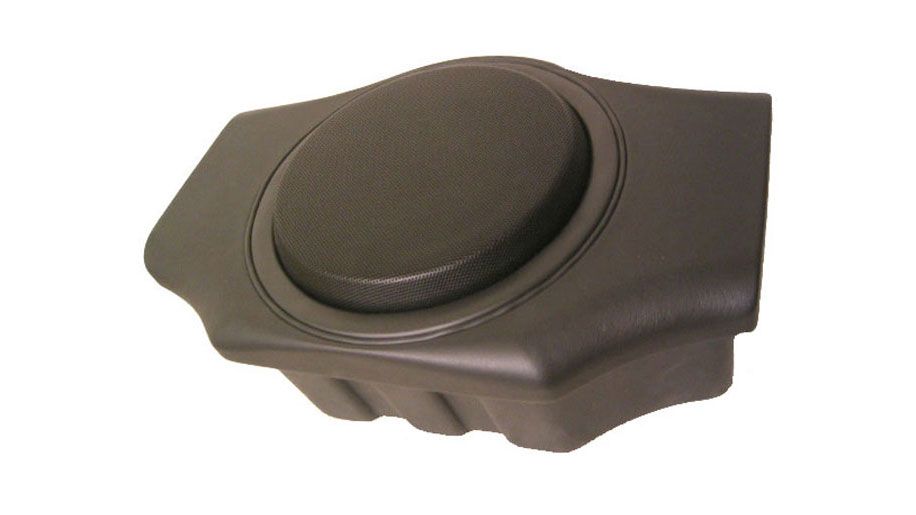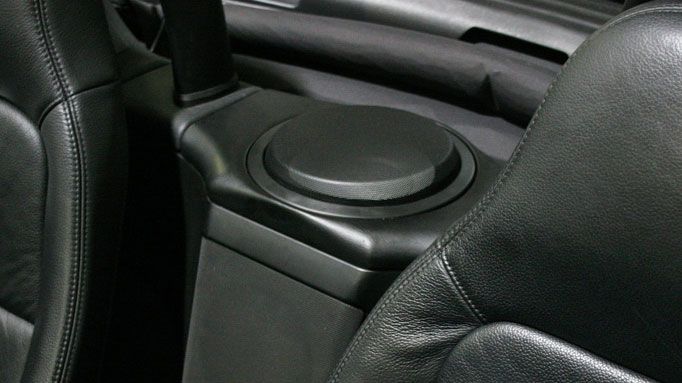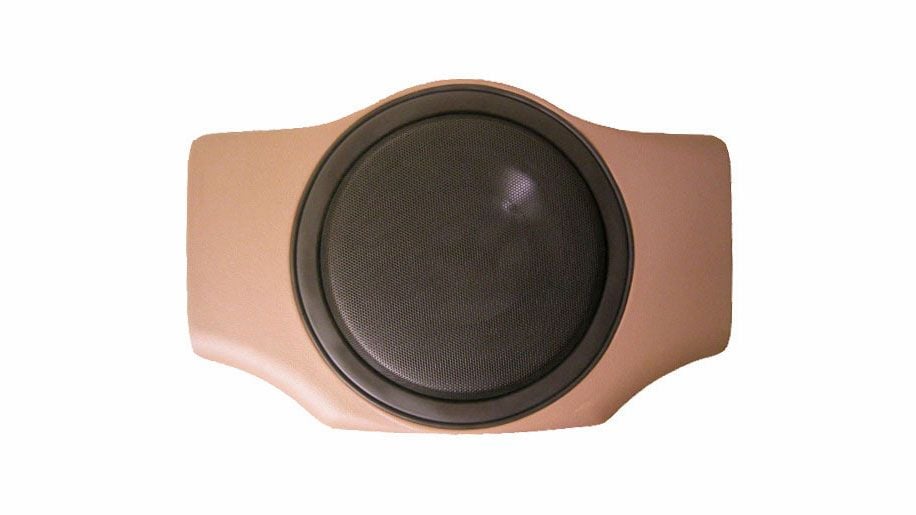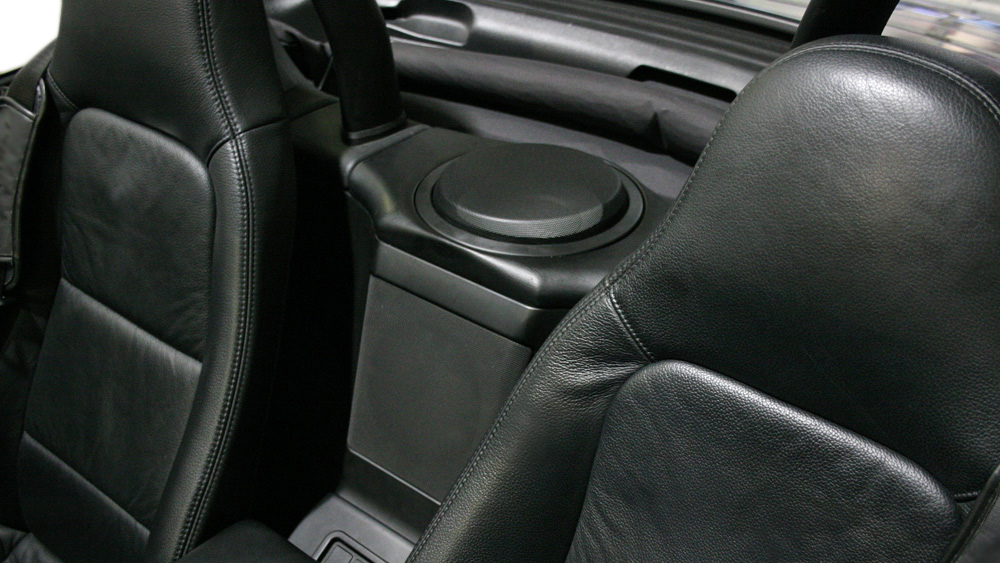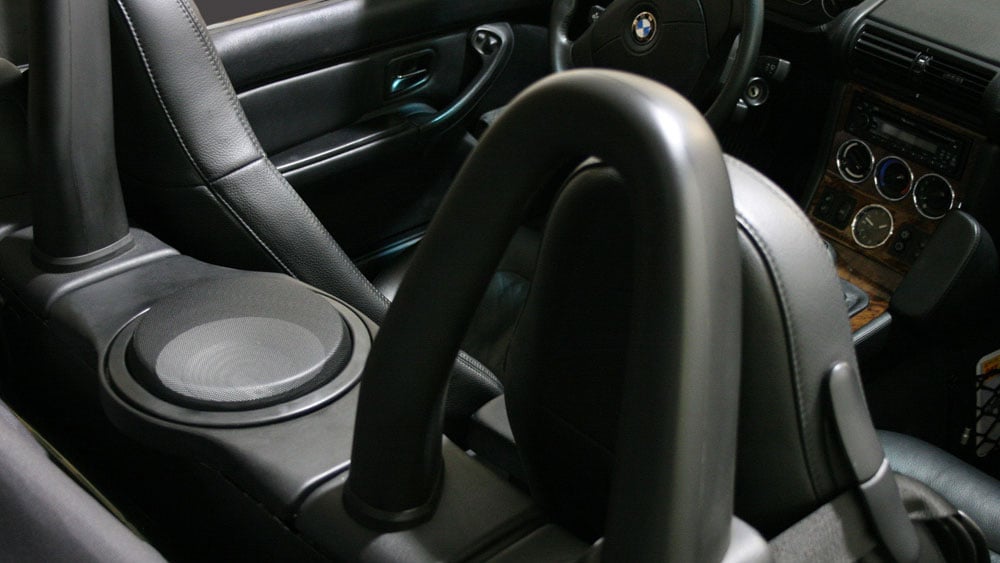- Home
- Select Your Vehicle
- BMW
- 1996-2002 Z3 Roadster [E36/7]
- BMW Z3 Model 81S Subwoofer
BMW Z3 Model 81S Subwoofer
Availability: Out of stock
The Model 81S is a perfect OEM-look drop-in replacement subwoofer system featuring a custom 8" subwoofer by Alumapro in a sealed enclosure, a high-quality subwoofer capable of producing some serious bass. The enclosure installs in the factory subwoofer (or storage compartment) location in between the seats, and reuses the existing factory mount points. The Model 81S offers incredible bass, great power handling, and smooth frequency response.
Will it Fit My Vehicle?
The Model 81S will fit any Z3 Roadster that came factory-equipped with roll hoops. You can use your existing factory amplifier (performance will be limited, but will exceed that of the factory subwoofer), or you can use a 2 channel aftermarket amplifier
What's Included:
- Model 81S enclosure
- Custom Dual Voicecoil Alumapro 8" Subwoofer
- Mounting Brackets & Hardware, Subwoofer Wiring Harness, Grille
What You'll Need:
- Amplifier - 100-250 watts [optional]
- Amplifier Wiring Kit [optional - if using aftermarket amplifier]
Specifications:
- Construction: Advanced Molded Composite Baffle, Hand-layup Fiberglass Enclosure
- Power Handling: 150 watts RMS/250 watts max
- Impedance: Dual 4 ohms
- Frequency range: 35-350 Hz
Find an Installer near you:
Looking for a qualified professional to handle installation for you? Check out our Find An Installer page.
Do it yourself:
Prefer to do it yourself? We've got you covered. Our installation instructions are the best around. If you can handle basic around-the-house-DIY projects, you can handle this.
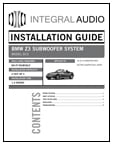
1996-2002 BMW Z3 Roadsters
Covers all BMW Z3 Roadsters. The Model 81S subwoofer will not fit Z3's that did not come with both a factory subwoofer and factory roll hoops
These are some of the most common questions about the Z3 Model 81S. Still don't see what you're looking for? Ask Us and we'll get you an answer lickity-split.
-
Can I use a different woofer?
Contrary to popular belief, woofers and enclosures are not interchangable. The air in the enclosure is a critical component of the subwoofers suspension, using a different woofer will give you a completely different system and response. There is no better woofer available for this particular application - it was designed for this specific enclosure and vice versa.
-
Why is the Model 81S louder, cleaner, and better than a subwoofer placed in the trunk?
Since the Model 81S is located in the cabin with the driver/passenger, it needs less power, creates fewer rattles, and has more even frequency response than a subwoofer placed in the trunk.
- Volume - Doubling the distance between listener and speaker quarters the acoustic power delivered to the listeners ear. A subwoofer in the trunk is at a minimum twice as far from the listener as the RoadsterSound enclosures. So without even considering the biggest obstacle to a trunk mounted subwoofer - all the metal and insulation between trunk and cabin - you'd still need four times the amplifier power and speaker power handling to produce the same volume at the listener's ear.
- Rattles/Vibration - Ever sit at a traffic light next to someone with loud bass and even louder rattles? That's what you'll sound like with a subwoofer in your Z3's trunk. There is a lot of metal and insulating material between the trunk and the cabin, and it makes getting sound out of it difficult. Inevitably, you end up creating a significant amount of rattling and vibration in the process. The end result is embarrassing, and for most folks, unbearable.
- Frequency Response - Sound can't pass through objects. It either passes around them or, if there is no path around the object, it vibrates the object which in turn vibrates the air on the other side and makes sound again. This is a large part of how sound gets out of your vehicle's trunk. Aside from the volume implications noted above, this wreaks havoc on your low end frequency response. A given solid object, be it a piece of sheet metal or a hunk of rubber, will not vibrate with the same ease across all frequencies, leaving your frequency response on the other side as bumpy as the Rocky Mountains.
-
The Model 81S speaker points up...won't all the sound be lost into the air above?
Short Answer: No, not at all. Low frequency sound is omni-directional - it travels outward evenly in all directions. The sound reaching the listeners ear from the installed Model 81S is identical to the sound that would reach the listener's ear if the speaker were pointed directly at the listener's ear. It's not intuitive, but it's true, and it remains true whether the top is up or down.
Longer Answer: To be more specific, all frequencies of sound can be directional or omni-directional. What determines whether or not sound is directional (think: beamed rather than radiated) is the ratio of the speaker's diameter to the wavelength of the frequency being produced. As the diameter of the speaker begins to approach the wave length of the frequency, the sound gradually begins to become directional. At a speaker diameter of 6 times the wavelength, the sound becomes an almost laser-like beam. At sea level, sound travels at about 1120 feet/second. So at 20kHz (20,000 cycles/second, the upper limit of human hearing) sound has a wavelength of about 2/3 of an inch. This means that with a tweeter as small as 3/4" (the diameter of many tweeters), the sound produced at 20kHz is already becoming directional, and with a speaker as small as 4" the sound is a laser-like beam. In contrast, at 50Hz (50 cycles/second) sound has a wavelength of over 22 feet. For sound to be relatively directional at this frequency you'd need a subwoofer 22 feet in diameter, and to create a beam of 50Hz sound you'd need a subwoofer over 130 feet in diameter! Try fitting that in a roadster.
You can test this yourself with your home theater (or home stereo with subwoofer) and a test tone CD. Place the speakers in the middle of a relatively large room (so that reflection isn't a large factor). Alternately play both low frequencies and high frequencies and walk in a full circle around the speakers. You'll notice that the higher frequencies drop off quite quickly as you approach the side and then rear of the speaker. However, once you get to test tones that are played exclusively by the subwoofer (80-100Hz and below) the sound is just as loud directly behind the subwoofer as it is in front of it. NOTE: You may encounter noticiably louder or softer areas that don't seem to relate to whether you are in front of or behind the subwoofer. These are standing waves. They will appear in an area parallel to a wall (assuming a rectangular room) and evenly spaced about the subwoofer (assuming the sub is in the center of the room). These are areas where the distance between the spot and the wall is an even multiple of the wavelength of the frequency being produced, and are a result of sound waves either combining or cancelling each other out.
-
Will my roadster's enclosure sound different with the top up/down?
Unfortunately, yes. This is a fact of life with convertibles. The roof, walls, and windows of a vehicle actually create a kind of speaker enclosure that serves to amplify low frequency sound. A good way to think of it is to imagine sitting inside a large speaker cabinet rather than outside. When the top is lowered, the elimination of this "enclosure" is exacerbated by increased road and highway noise. The Integral Audio Phantom™ subwoofer enclosures compensate for this in ways the OEM sound systems can't - by having great low frequency extension and high power handling.

